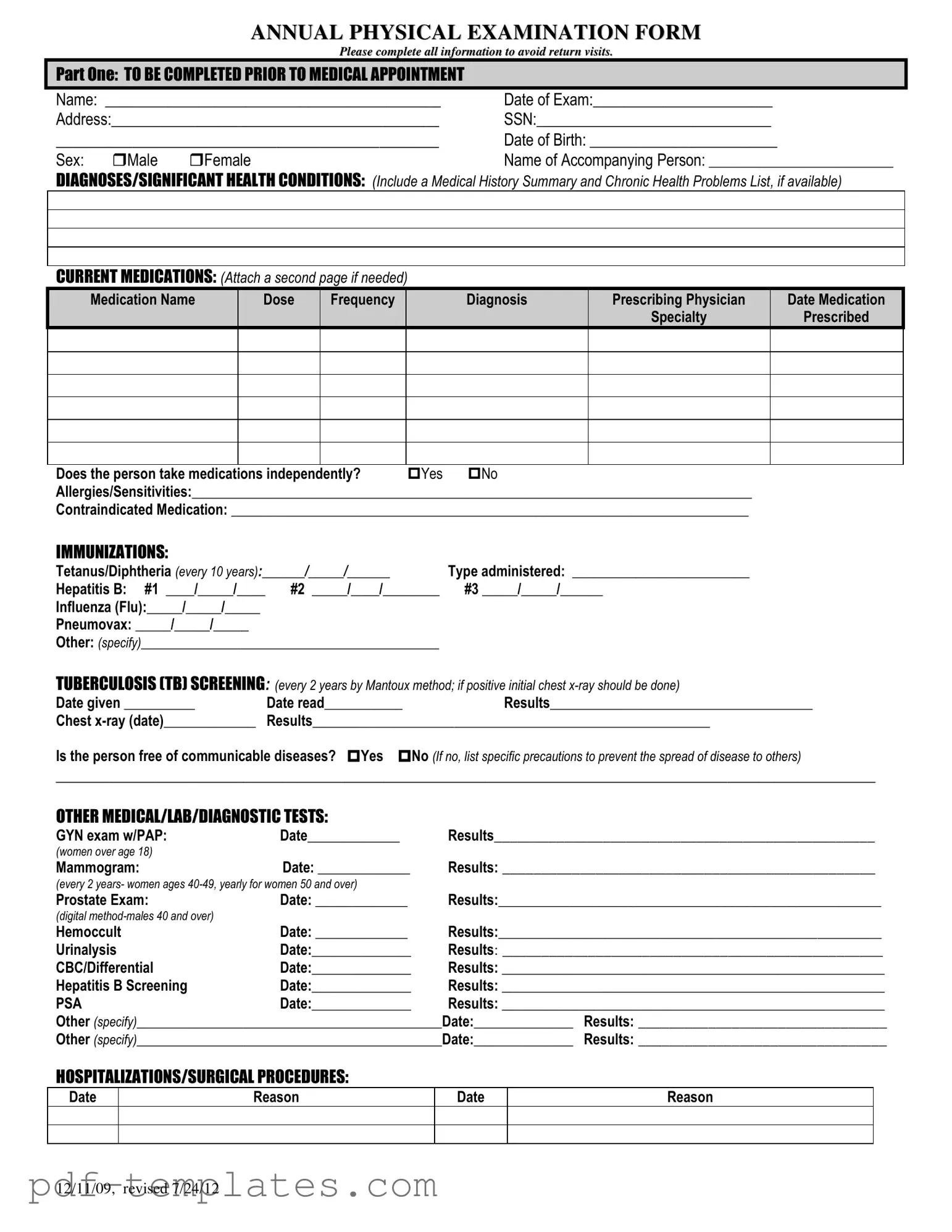The Annual Physical Examination form shares similarities with the Patient Intake Form, commonly used in healthcare settings. Both documents require personal information such as name, date of birth, and contact details. They also gather medical history, including current medications and allergies. This information is crucial for healthcare providers to understand a patient's background and tailor their care accordingly. While the Patient Intake Form may focus more on initial visits, the Annual Physical Examination form emphasizes ongoing health assessments.
Another document similar to the Annual Physical Examination form is the Health History Questionnaire. This questionnaire delves into a patient’s past medical history, including surgeries, chronic illnesses, and family health history. Like the Annual Physical Examination form, it aims to provide a comprehensive overview of a patient’s health, ensuring that any potential issues are addressed during their visit. Both documents serve as tools for healthcare professionals to create effective treatment plans.
The Medication Reconciliation Form is also akin to the Annual Physical Examination form. Both documents track medications a patient is currently taking, including dosage and frequency. This is vital for preventing medication errors and ensuring that healthcare providers have an accurate understanding of a patient’s treatment regimen. The Annual Physical Examination form expands on this by including additional health information relevant to the patient’s overall wellness.
Similarly, the Immunization Record serves a comparable purpose. It documents a patient's vaccination history, which is a key component of preventive healthcare. The Annual Physical Examination form incorporates immunization details as part of a broader health assessment. Both documents highlight the importance of vaccinations in maintaining health and preventing disease outbreaks.
The Consent for Treatment form is another related document. It ensures that patients understand and agree to the medical procedures they will undergo. Like the Annual Physical Examination form, it emphasizes the importance of informed consent in healthcare. Both documents prioritize patient autonomy and the need for clear communication between patients and providers.
The Laboratory Test Request Form shares similarities with the Annual Physical Examination form, particularly in the context of diagnostic testing. Both documents may request lab tests based on a patient’s symptoms or health history. The Annual Physical Examination form may include lab test results, providing a more comprehensive view of the patient's health status, while the Laboratory Test Request Form focuses specifically on ordering tests.
The Referral Form is another document that aligns with the Annual Physical Examination form. It is used when a primary care provider refers a patient to a specialist for further evaluation or treatment. Both forms collect relevant patient information and medical history to ensure a smooth transition and continuity of care. The Annual Physical Examination form may indicate the need for referrals based on findings during the exam.
The Follow-Up Appointment Form is also comparable. This document is used to schedule subsequent visits based on the findings of an initial examination. Similar to the Annual Physical Examination form, it may include recommendations for further evaluation or treatment. Both forms play a critical role in managing ongoing patient care and ensuring that health issues are monitored over time.
The Advanced Care Planning Form is another relevant document. It addresses a patient’s preferences regarding future medical care and treatment options. While the Annual Physical Examination form primarily focuses on current health status, both documents encourage patients to think about their health goals and make informed decisions. This is particularly important for patients with chronic conditions or those nearing the end of life.
When considering financial management documents, the California General Power of Attorney form plays a crucial role by enabling an individual, known as the principal, to appoint an agent for financial decision-making. This form becomes particularly significant in circumstances where the principal is unable to oversee their financial affairs. It encompasses various powers related to financial management, from accessing bank accounts to navigating real estate transactions, making it an invaluable tool in stewardship. For more resources, you may refer to All California Forms that offer comprehensive templates and guidelines.
Finally, the Discharge Summary is similar to the Annual Physical Examination form in that it provides a comprehensive overview of a patient’s health status and care plan after a medical visit or hospitalization. Both documents summarize key findings, treatment recommendations, and follow-up care, ensuring that patients have a clear understanding of their health and what steps to take next.
